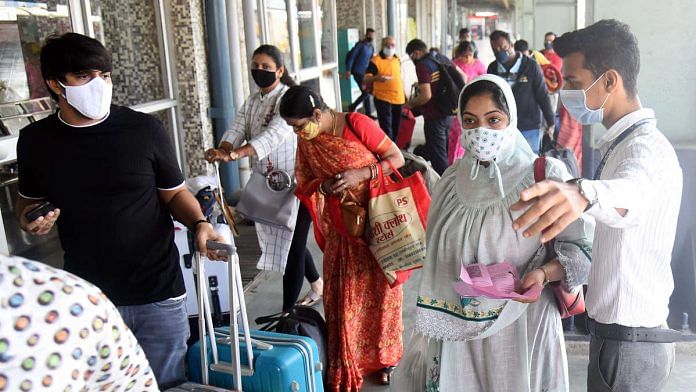Mumbai/Nagpur: There is a sharp contrast in the way Covid-19 cases counts are progressing in Maharashtra and its capital, Mumbai.
Saturday, Mumbai registered 3,568 cases, down from nearly 6,000 Monday. In the same period, the cases in the state rose to 46,393 from 31,111. Maharashtra’s Friday figure of 48,270 was the highest so far in the third wave.
The test positivity rate — the number of positive cases detected as compared to the total tests — for Mumbai dropped to 7 per cent Saturday from 10 per cent the previous day. The test positivity for the whole state was 23.4 per cent Friday, up from 20 per cent Thursday.
Also read: 67% Indians would support if govt gives free N95 masks to all: Survey on Covid fight
BMC was ready for the fight
When ThePrint analysed data for Mumbai, the total daily testing in the city in the week starting Monday (17 January) hovered in the range of 47,000-52,000, a drop from a range of 55,000-65,000 a week earlier. However, Additional Municipal Commissioner Dr Suresh Kakani told ThePrint that the city wasn’t cutting the number of daily tests but was aggressively contact-tracing positive patients.
“We tracked all the patients who came in contact with the positive patients and enforced home quarantine strictly through ward war rooms, because of which we could contain the spread,” said Kakani.
According to the Brihanmumbai Municipal Corporation (BMC) dashboard, in the last two days, the total bed occupancy dropped to nearly 4,200 from over 5,000 and the active cases between 11 January and 21 January dropped to 14,000 from over 100,000.
“We augmented all our resources like increasing the number of beds, oxygen, medical supply, manpower, and all this acted to keep the confidence in the system alive and helped manage the wave,” said Kakani.
He also told that according to the BMC’s initial analysis, 93 per cent of the cases were reported from high-rises while only 7 per cent came from densely populated areas in this third wave.
Herd immunity, vaccination and an increased emphasis on inoculating people living in slums helped contain the spread in those areas, Kakani said.
According to the BMC, about 90 per cent of the city is double-vaccinated, while “over 100 per cent” are vaccinated with one dose, since Mumbai also vaccinates the residents of neighbouring satellite towns.
Also read: Amravati, where Delta emerged & wrought havoc, calm in Omicron wave. Authorities remain alert
Rest of Maharashtra is a worry
According to the state health department data, Pune is the major contributor to Maharashtra’s overall tally, followed by Nagpur. Pune added over 11,000 cases Friday, while Nagpur contributed over 4,000 cases.
However, low hospitalisation in the third wave has helped the state to a greater degree, Radhakrishnan B., commissioner, Nagpur Municipal Corporation, told ThePrint.
Many municipal corporations were also better prepared for the third wave in terms of infrastructure. ThePrint spoke to district officials in Amravati, Nagpur, Mumbai, Pune who said they ramped up infrastructure in terms of hospital beds, oxygen capacity and oxygen generation plants. But the number of growing cases is still a concern.
“The cases are bound to increase (in Nagpur),” Radhakrishnan told ThePrint. “Fortunately, not even 10 per cent of our beds are full. We may face more hospitalisations, but we are well prepared as we have taken care of hospital beds, oxygen and also created ward war rooms like Mumbai,” he said.
The cases could continue to rise in the state, officials expect.
Deputy Chief Minister Ajit Pawar, who is also the guardian minister of Pune district, Saturday deferred the decision to reopen schools in the district owing to the rising number of cases.
“We will monitor the situation in Pune for another week and only then will we decide to open schools in the district,” Pawar said while speaking to reporters in Pune.
(Edited by Manoj Ramachandran)
Also read: Omicron could replace other Covid variants, survive as common cold: Harvard immunologist Pillai






